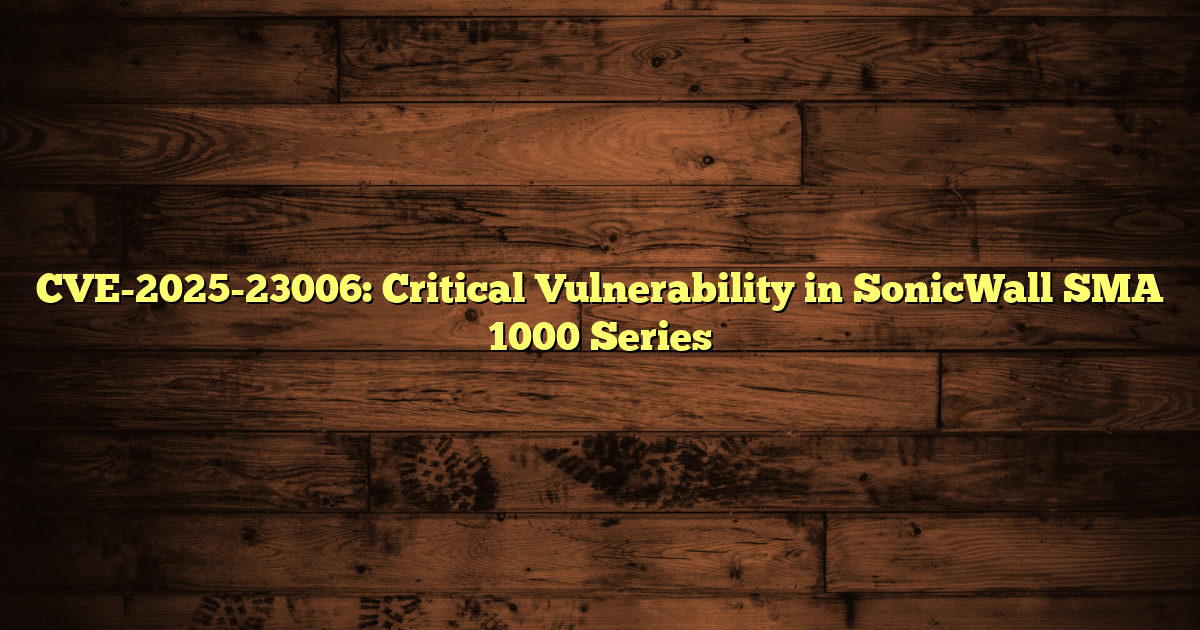CVE-2025-23006: Critical Vulnerability in SonicWall SMA 1000 Series
CVE-2025-23006: Critical Vulnerability in SonicWall SMA 1000 Series
Table of Contents:
What is CVE-2025-23006?
Why Is It So Dangerous?
Which Products Are Affected?
Active Exploitation Activity
Severity Assessment
Recommended Remediation Steps
Rapid Weaponization
Broader Trends in Cybersecurity
Federal Directives
Actionable Steps for Organizations
Vigilance Going Forward
FAQ
Do you believe your network is completely safe? Think again. CVE-2025-23006, a severe security flaw in SonicWall’s SMA 1000 series, poses a significant threat to your system’s integrity.
What is CVE-2025-23006?
CVE-2025-23006 refers to a security hole in SonicWall’s Secure Mobile Access (SMA) 1000 series. It targets the Appliance Management Console (AMC), along with the Central Management Console (CMC). The vulnerability allows remote attackers, without needing authentication, to run operating system commands on devices.
Why Is It So Dangerous?
The dangerous character of this vulnerability stems from a pre-authentication deserialization of untrusted data flaw.
- Attackers don’t require any credentials.
- The flaw facilitates remote exploitation.
- It enables execution of commands, granting potentially total control over the SMA appliance.
It works when applications handle serialized data from untrustworthy sources without correct checks. The result is that attackers craft nasty objects that, when processed, start unintended code execution, also other damaging actions.
Which Products Are Affected?
Multiple models in the SonicWall SMA1000 series are affected:
- SMA6200
- SMA6210
- SMA7200
- SMA7210
- SMA8200v (Virtualized versions on ESX, KVM, Hyper-V, AWS, furthermore Azure)
- EX6000
- EX7000
- EX9000
These appliances are often used for secure remote access in many enterprise environments.
Active Exploitation Activity
SonicWall disclosed the vulnerability publicly on January 22nd. Soon after, it was confirmed that attackers were actively exploiting vulnerable systems. The Cybersecurity Infrastructure Security Agency (CISA) added CVE-2025-23006 to its Known Exploited Vulnerabilities Catalog. CISA is a U.S. federal agency. It coordinates cybersecurity defense across government networks and critical infrastructure. They recommend immediate action for all organizations with affected products.
Severity Assessment
CVE-2025-23006 gets a “critical” rating with a CVSS score of 9.8 out of 10. This shows a very high risk. Its high risk stems from how easily it is to exploit and the level of impact, with potential for full system compromise. Another system, the Exploit Prediction Scoring System (EPSS), estimates the likelihood of exploitation. It rates this vulnerability high, with about a 49.8% chance of exploitation after disclosure.
Recommended Remediation Steps
SonicWall released firmware updates, beginning with version 12.4.3-02854. These patches address the problems. It is urged to apply these patches at once, as well as put in place other security practices.
Take these steps:
- Restrict console access with network segmentation. Or, set firewall rules. This way, the management interfaces, listening on default TCP port 8443, are accessed only from trusted networks.
- For appliances connected both internally externally, limit admin console access to internal interfaces.
These steps help reduce the attack surface as you deploy the patch, or if patching right away isn’t doable.
Rapid Weaponization
The active exploitation showed how fast attackers move after vulnerabilities are known. This is especially true for zero-day flaws like CVE-2025-23006, where no fix was out before the attacks. This illustrates the challenges in securing perimeter devices providing remote access. Cyber threats are becoming increasingly sophisticated.
Broader Trends in Cybersecurity
This incident shows that deserialization vulnerabilities remain a major vector for attacks. Attackers use them to bypass traditional authentication. This happens if there is unchecked input handling within software components for serialized data.
Federal Directives
Federal agencies must fix known exploited vulnerabilities fast. That’s per CISA mandates under Binding Operational Directive BOD 22–01. This is designed to reduce risk caused by actively targeted weaknesses. Private sector should act with similar urgency, given the extensive uses for SonicWall appliances outside government.
Actionable Steps for Organizations
Given its severity combined with exploitation reports since its discovery in January 2025, organizations using affected SonicWall products must act fast. Patch first, also use controls to restrict interface exposure.
This is in line with security approaches highlighting quick action against zero-day attacks targeting critical components. These provide secure remote connectivity. This is vital because hybrid workforces rely on VPNs managed with such appliances.
Vigilance Going Forward
As no public exploits have been released, vigilance is essential throughout the rest of 2025. Attackers tactics can change and they can start targeting software weaknesses.
Awareness campaigns from cybersecurity authorities, including CISA, added to vendor advisories from SonicWall, help to mitigate risks involved with high-impact zero-day flaws. All stakeholders get involved with coordinated disclosure-response cycles.
FAQ
What is a pre-authentication deserialization of untrusted data flaw?
It is a type of vulnerability where an attacker is able to send malicious data to a system without needing to log in first. This data, when processed by the system, leads to unexpected and harmful actions, like running commands or taking control.
How do I find out if my SonicWall appliance is vulnerable?
Check your appliance model against the list of affected products provided in SonicWall’s security advisory for CVE-2025-23006. Verify your firmware version and compare it with the fixed version (12.4.3-02854 or later).
What if I cannot patch my system immediately?
If immediate patching is not doable, apply temporary mitigations like restricting access to the administrative console and limiting connections to internal interfaces. Patch as fast as you possibly can.
Resources & References:
- https://arcticwolf.com/resources/blog/cve-2025-23006/
- https://www.truesec.com/hub/blog/sonicwall-sma1000-cve-2025-23006-vulnerability
- https://www.cisa.gov/news-events/alerts/2025/01/24/cisa-adds-one-known-exploited-vulnerability-catalog
- https://www.tenable.com/cve/CVE-2025-23006
- https://www.cybereason.com/blog/cve-2025-23006-sonicwall-critical-vulnerability





